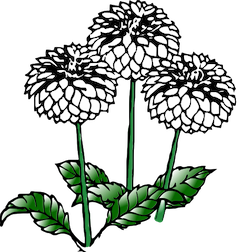 | dahlia society of victoria | LOGIN: |
As older varieties disappear from the scene, new varieties must be produced to replace them. Because dahlias do not self-pollinate the seed-grown plant will be a hybrid, never identical to the seed parent. By growing new plants from seed you can enjoy breeding new varieties. |
| Hybrid seed is produced naturally in every dahlia plot as insects, mainly bees but also butterflies, move from flower to flower transferring pollen as they hunt for nectar. Plants grown from this source will vary wildly - most will not be worth keeping because of poor form or weak growth. Breeders can exercise some control over which plants are crossed to make the outcome a little more predictable. The simplest way is to plant the varieties you would like to cross close together - bees tend to move from blooms on one plant to an adjacent plant. Tying the desired parents to the one stake helps. Breeders who grow in shadehouses sometimes install curtains of shadecloth that separate groups of plants to discourage pollinators from crossing between them. |
The highest degree of control is exercised by hand pollinating. The parents are selected, pollen transferred by hand and the heads are then covered to isolate them - removing all the ray florets makes this easier. Even with the same parents the offspring will still be very variable because of the Dahlia's genetic complexity. |
The seed pods are collected as they dry out and feel tight and full. In nature the seed pod normally contains from 25 to 50 seeds. Hand pollination produces fewer seeds because the hand of man is not as clever as the bee in getting the timing right. The seeds are then extracted and left to dry. They must then be stored and kept dry until Spring. Using pill bottles with sachets of silica gel left in is a good choice. Labelling is of the utmost importance - you will know the mother (the seed parent) but unless you have pollinated by hand you will at best have a short list of probable fathers! |
|
In the Spring the saved seeds are planted in seed trays (labelled) and then it’s a matter of waiting to see what develops. Most will be disappointing. Even when new varieties look attractive, they should be evaluated over several seasons. Some promising varieties lose their form over time. Others have tubers that are hard to keep, or the plants may be susceptible to diseases or they may simply die out without any obvious explanation. |

